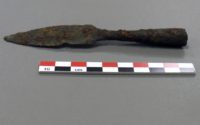 A rare iron arrowhead estimated to be about 1,000 years old has been discovered in the mountains of the Hardanger Plateau in central southern Norway. Local resident Ernst Hagen found it lying casually on the ground when he was out for a walk outside his mountain cabin near the spectacular Vøringsfossen waterfall. (He’s in rarified company; composer Edvard Grieg had a cabin there too.)
A rare iron arrowhead estimated to be about 1,000 years old has been discovered in the mountains of the Hardanger Plateau in central southern Norway. Local resident Ernst Hagen found it lying casually on the ground when he was out for a walk outside his mountain cabin near the spectacular Vøringsfossen waterfall. (He’s in rarified company; composer Edvard Grieg had a cabin there too.)
Realizing the hunting tool had to predate the use of firearms, Hagen took the 12 cm (4.7 inches) iron arrowhead to the county council where archaeologist Tore Slinning confirmed it was a historic piece and no comparable finds had been reported in Hordaland county. Experts have estimated it to date to the early Middle Ages based on its design.
The plateau, the largest eroded plain plateau in Europe, has a cold alpine climate and is home to the Hardangerjøkulen glacier, one of Norway’s largest. There is archaeological evidence of villages in the area going back to the Neolithic era. These are believed to have been nomadic settlements occupied temporarily by hunters following the migrating herds of reindeer. Even today the plateau is home to some of the largest herds of reindeer in the world who cross from their winter feeding grounds east of the plateau to their summer breeding grounds on the west side.
Artifact finds are extremely rare in the area, with small objects destroyed by the glacier movement or covered in ice and snow. Norway’s glaciers have shrunk by 12% over the past 50 years, however, and the glacier retreat is rapidly increasing due to climate change. As with other endangered cold environments, archaeological finds that would otherwise be preserved indefinitely in the ice are being exposed by thaw.
 The arrowhead is rusted and could have been so since shortly after the medieval reindeer hunter missed his quarry a thousand years ago. It may also have oxidized very recently when the artifact was exposed to the air after the ice melted. The same goes for the wooden shaft and fletching which have not survived. If the arrow was trapped in soil, they may have decomposed over many centuries. If the whole thing was encased ensconced in ice, on the other hand, we may have lost them very recently.
The arrowhead is rusted and could have been so since shortly after the medieval reindeer hunter missed his quarry a thousand years ago. It may also have oxidized very recently when the artifact was exposed to the air after the ice melted. The same goes for the wooden shaft and fletching which have not survived. If the arrow was trapped in soil, they may have decomposed over many centuries. If the whole thing was encased ensconced in ice, on the other hand, we may have lost them very recently.
The arrowhead is now being conserved at the University Museum in Bergen. It will be stabilized so that it does not continue to corrode and experts will attempt to narrow down its date of manufacture.
—————-
You have: 13cm
You want: inch
13cm = 5.1181102 inch
—————-
At a full length of roughly 13cm I wonder what kind of deer was possibly preyed at, and if we would possibly be dealing here with a Nordic ‘pilum’ or spearhead:
From the early 3rd century battleground site at the Harzhorn hill (Battle at the Harzhorn), there is mainly Roman looking spear- and arrowheads (and even heavier artillery) plus a few clearly Germanic ones. There is a huge Germanic pilum at roughly 20cm, but the arrowheads are significantly smaller.
Maybe, there was more hidden under the glacier, and they find the “hunterer” as well –Note that poor Ötzi was found with his full kit! Particularly, the arrowhead that had killed him was hardly any longer than 2cm– or, our hunterer had decided that this ‘monster of an arrowhead’ was simply too heavy (and all the reindeer had laughed at it). Moreover, some of the Harzhorn weapons had inscriptions (that a medieval weapon might of course lack).
:hattip:
Friends,
As a re-enactment archer and a student of medieval archery, this piece seems to me way too large to be an arrowhead. It is even a bit too large to be a crossbow bolt (the largest one in my collection is 9 cm), though it could have come from a ballista or springald bolt. These were usually siege/castle defense weapons, so its find in the middle of nowhere makes this unlikely. Like Jenny, I suggest this could have been a javelin or spear point, and the broad blade suggests the latter.
Too bad nobody ever thinks to measure, or at least talk about, the size of the socket, both inside and the outside dimensions. This could tell us the likely size of the shaft. When I was doing statistical work on existing English arrow points, I enquired about this dimension on points at the Museum of London. The historian with whom I corresponded told me they had never thought to measure the sockets. They put a docent to work, and two weeks later sent me four pages of data, including the interior socket sizes of almost all the points in their collection. Pure gold! I was able to determine that a fair selection of their points would have fitted the replica arrows I make to shoot as a re-enactor.
Yours Aye,
Mungo Napier, Laird of Mallard Lodge (SCA)
(aka Garth Groff in the modern world)
The irony of ‘climate change’ is that if the glacier melts and reveals additional discoveries, then the ‘climate change” is actually reverting back to how the climate used to be.
On the question of climate change, just because we are finding things left by a glacier does not mean we are returning to how the climate used to be when these things were lost. A significant amount of hunting or travelling is done on the glacier, so when something is lost it quickly freezes and begins to be encased after the next snowfall. When the climate warms, those things on the edges of the melting glacier fall out or otherwise exposed.